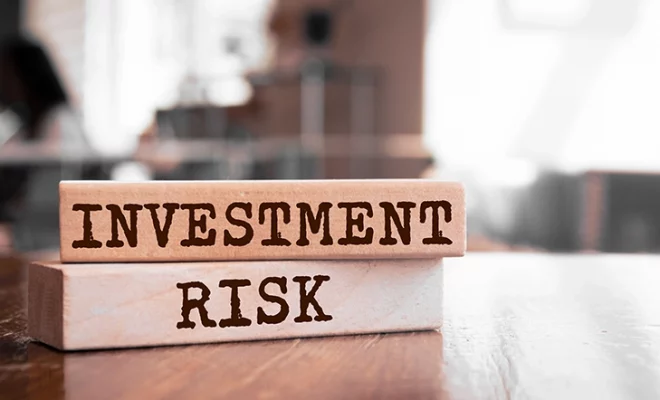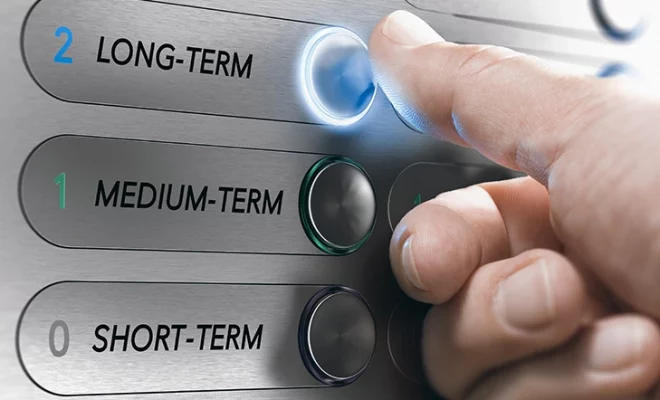How to Determine Your Investment Risk Tolerance Level

Investment and risk are two closely related concepts. Risk refers to the potential for loss or negative returns when you invest your money in a market-linked security. There are different types of risks, including market, credit, inflation, and liquidity risk, among others. While no investment is entirely devoid of risk, and there is always some degree of threat to your money when you put it in the market, you can manage risk and protect your investments with some strategies. It is essential to choose investments that match your risk appetite to avoid unnecessary stress and surprises later.
A financial advisor can help you understand your investment risk tolerance. This article will focus on the risks of investing, how they impact you, and what you can do to determine your risk appetite.
Table of Contents
What is risk tolerance?
Risk tolerance is a measure of your ability to handle financial risks. It is the amount of risk that you are willing to take to achieve your desired investment goals. Risk tolerance can be influenced by a range of factors, including your age, income, experience and attitude towards risk. Risk tolerance plays a critical role in decision-making and forms the basis of your portfolio selection. Every asset has its unique risks, and it is important for you to understand how that fits into your preferences.
Some investors have a high-risk tolerance. This means that they are willing to take on more risk in their investments to chase after potential higher returns. Others may have a lower risk tolerance and may prefer to invest in lower-risk investments with more modest returns. For example, younger individuals may have a higher risk tolerance as they have more time to recover from potential losses. They also have more chances to earn money, as they may be starting their careers and would likely go up the ladder, make more money, and invest the same to make a higher yield. On the other hand, older individuals may have a lower risk tolerance as they have less time to recoup losses before retirement. Moreover, earning more money is difficult as you get older, which limits the amount of money you can invest.
Risk appetites may change over time as you age, earn more or less, and have other financial liabilities or responsibilities. However, you must know your risk tolerance at every phase, as it can help guide your investment choices and ensure that your investments align with your goals and preferences.
Difference between risk tolerance and risk capacity
Although often used synonymously, risk tolerance and risk capacity are both very different concepts. Risk tolerance refers to your willingness and ability to take risks in your investments. It is typically based on personal factors such as your age, income, financial goals, and personal preferences. Risk tolerance is a subjective measure and can vary from person to person. For example, a person who is generally confident and daring may have a higher risk tolerance in investing because of their innate comfort with risk and willingness to take chances in life.
Risk capacity refers to your financial ability to take on risk. It is typically based on objective financial factors such as income, expenses, assets, and liabilities. For example, a person with a high net worth may have a high-risk capacity, as they have adequate financial means to weather potential investment losses.
Factors that can influence your investment risk tolerance
There are several factors that can influence your risk tolerance level. By taking these factors into account and evaluating your overall financial situation, you can determine your personal risk tolerance level.
- Your investment timeline: The time for which you hold your investments can affect your risk tolerance. A longer investment horizon allows you to be more aggressive as you have more time in the market to earn a higher yield and recover from potential losses. Conversely, a shorter investment horizon may push you to be more conservative, as your money will get little time to earn returns and recoup potential losses.
- Your financial goals: If you are investing for long-term goals, such as retirement or education expenses, you may be more comfortable taking on higher-risk investments. But if you are investing for short-term goals, such as a down payment on your house or a vacation, you may prefer lower-risk investments.
- Your age: Younger investors may be more willing to take on higher-risk investments as they have a longer investment horizon and more time to recover from losses. As you approach retirement and grow older, you may prefer lower-risk investments to ensure your funds are preserved for your retirement years.
- Your portfolio size: Investors with larger portfolios may be more willing to take on higher-risk investments as they have more funds to absorb any potential losses. Investors with smaller portfolios may prefer lower-risk investments to avoid possible losses that can further diminish the value of their portfolio.
5 steps to determine your investment risk tolerance level
Here are some steps to help you determine your investment risk tolerance level:
1. Evaluate your financial goals
Evaluating your financial goals is the first step in financial planning, as it helps you determine the course of action. Your goals are also an essential factor to consider when evaluating your risk tolerance. Your goals will determine the timeline for your investment, which will ultimately impact your ability to take on risk. For instance, if your goal is to save for retirement in 30 years, you may be more comfortable taking on higher-risk investments to achieve higher returns. In this case, you may invest in stocks, which is an example of a high-risk investment. Stocks carry high risk but can also deliver returns at par with inflation. Hence, they can be ideal for a long-term goal like saving for retirement and ensure that your money does not lose value in the future due to inflation. However, if your goal is to save for a car that you wish to buy in a year’s time, you may benefit more from maintaining a conservative risk tolerance and investing in fixed-income options like bonds, CDs, money market accounts, etc.
2. Understand the different types of risk
There are various risks associated with investing. Understanding the different types of investment risks can help you make a well-informed decision about whether or not you are comfortable with them. Each type of risk can impact the performance of your investments in different ways. For example, market risk is the risk of your money losing value due to fluctuations in the overall market. It is most commonly associated with stocks and equity mutual funds. Inflation risk is the risk that your investments will lose value with inflation. This type of risk is commonly associated with savings accounts and cash. Bonds have credit risk, which refers to the possibility of the bond issuer defaulting on their obligations.
There are several other risks of investing. Make sure you know what these are before choosing any investments.
3. Consider your current financial situation
Your current financial situation can impact your risk tolerance. If you are earning well, have no debt, and are in a secure job, you may be more comfortable with taking on more investment risk. A stable income source, a large portfolio, and minimal or no liabilities can offer you the confidence to take chances. However, if you have debt, earn less, have a small portfolio, or fear losing your job, you may want to keep your risk tolerance conservative or moderate. For instance, if there are mass layoffs in your company, now may not be the time to add too much risk to your portfolio and focus more on assets that can offer you a steady income to secure your future. In this case, you must evaluate your current income, expenses, debt, and other assets to determine how much risk you can afford to take on.
4. Assess your comfort level with risk
Your personal preferences and comfort level with risk are essential factors to consider when evaluating your risk tolerance. You need to consider how you would react to a significant loss in your investments. If the idea of losing money makes you uncomfortable, you may choose low-risk investments. On the other hand, if you are willing to take on more risk to achieve higher returns potentially, you may be more comfortable investing in higher-risk investments. It is essential to be honest with yourself about your financial goals, preferences, and overall comfort level with risk. At times, you may be influenced by people around you and make decisions based on your peers and their experiences. However, this will likely go against you. Therefore, it is better to be honest with yourself and then take a call.
5. Consider working with a financial advisor
A financial advisor can also help you evaluate your risk tolerance and develop a strategy that aligns with your financial goals and preferences. A financial advisor can help you identify your investment risk tolerance, understand the different types of investment risks, and develop a strategy that balances risk with potential returns. They can also help you understand the possible consequences of different investment decisions and make informed choices that align with your financial goals. A financial advisor can also provide ongoing support and guidance over the years. Since your risk tolerance is bound to change as you grow old, consulting with a professional can be advisable. Your financial advisor can help you modify your investment portfolio at the right time to accommodate your altering risk appetite.
Which risk tolerance level do you fall under?
Based on the information above, you may belong to one of the following risk tolerance groups listed below. This can help determine the type of investments suitable for you.
1. Conservative risk tolerance
Investors with a conservative risk tolerance focus more on capital preservation rather than appreciation. These investors invest in low-risk investment options like savings accounts, Certificates of Deposit (CDs), government bonds, etc. Conservative investments have the lowest risk but also the lowest potential return. But they can help preserve capital and provide a steady, predictable income. It is essential to understand that while these investments are low-risk, they may not keep up with inflation over the long term, which can erode your purchasing power.
2. Moderate risk tolerance
Investors with a moderate risk tolerance tread between high and low-risk investments. They aim to balance risk and return by investing in a combination of high and low-risk instruments. Moderate investments have a moderate level of risk and potential return. These investments typically involve a mix of stocks and bonds. While stocks offer the chance to beat inflation and earn a higher yield, bonds balance out the risk by providing steady returns. It is important to note that moderate investments may not provide the same level of stability as conservative investments. But they do offer the potential for higher returns over the long term.
3. Aggressive risk tolerance
Investors with an aggressive risk tolerance focus more on capital appreciation rather than preservation. Aggressive investments have the highest level of risk and offer the potential for high returns. These investments typically include stocks, options and futures, cryptocurrencies, etc. The goal of aggressive investing is to generate the highest possible returns, but there is a higher risk of losing money. Investors with an aggressive risk tolerance must be comfortable with market volatility and should be willing to accept greater risk in exchange for the potential of earning higher returns.
To conclude
Ultimately, determining your investment risk tolerance level is an essential step in achieving long-term financial success. With numerous investment options in the market and newer avenues opening up, it can be easy to become overwhelmed or take on more risk than you are comfortable with. What feels comfortable for one investor may not be suitable for another. By understanding your risk tolerance and developing an investment strategy that aligns with your financial goals and preferences, you can build a portfolio that helps you achieve your financial objectives while also mitigating potential investment risks.
WiserAdvisor’s free advisor match service can help you find a financial advisor who can help you determine your risk tolerance. By answering a few basic questions about your financial needs, you can be connected to 1-3 advisors who are best suited to meet your financial requirements using our matching tool.




















